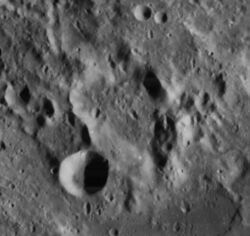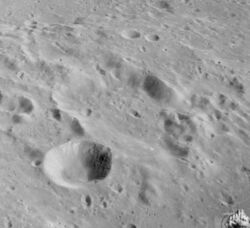Astronomy:Hypatia (crater)
 Lunar Orbiter 4 image | |
| Diameter | 41 × 28 km |
|---|---|
| Depth | 1.4 km |
| Colongitude | 338° at sunrise |
Hypatia is a lunar impact crater along the northwest edge of Sinus Asperitatis, a bay on the southwest edge of Mare Tranquillitatis. It was named after Egyptian mathematician Hypatia of Alexandria.[1] The nearest crater with an eponym is Alfraganus to the west-southwest. However, farther to the south-southeast, across the lunar mare, is the prominent crater Theophilus.
Hypatia is an asymmetrical formation with a rugged, irregular outer rim cut through in several places by narrow clefts. It is generally longer along an axis running to the north-northwest, with the widest outward bulge occurring on the west side at the northern end. It resembles a merger of several crater formations with a common interior floor. Attached to the exterior rim along the southwest is the satellite crater Hypatia A, a more symmetrical, bowl-shaped crater.

Rimae Hypatia
About 70 kilometers to the north of Hypatia is a system of linear rilles designated Rimae Hypatia, running about 180 kilometers across the Mare Tranquillitatis, and generally following a course to the south-southeast. The part of the rilles close to the crater Moltke was informally called U.S. Highway 1 by the Apollo 10 and Apollo 11 crews.
Satellite craters
By convention, these features are identified on lunar maps by placing the letter on the side of the crater midpoint closest to Hypatia.
| Hypatia | Latitude | Longitude | Diameter |
|---|---|---|---|
| A | 4.9° S | 22.2° E | 16 km |
| B | 4.6° S | 21.3° E | 5 km |
| C | 0.9° S | 20.8° E | 15 km |
| D | 3.1° S | 22.7° E | 6 km |
| E | 0.3° S | 20.4° E | 6 km |
| F | 4.1° S | 21.5° E | 8 km |
| G | 2.7° S | 23.0° E | 5 km |
| H | 4.5° S | 24.1° E | 5 km |
| M | 5.3° S | 23.4° E | 28 km |
| R | 1.9° S | 21.2° E | 4 km |
References
- ↑ "Hypatia (crater)". Gazetteer of Planetary Nomenclature. USGS Astrogeology Research Program.
- Andersson, L. E.; Whitaker, E. A. (1982). NASA Catalogue of Lunar Nomenclature. NASA RP-1097.
- Bussey, B.; Spudis, P. (2004). The Clementine Atlas of the Moon. New York: Cambridge University Press. ISBN 978-0-521-81528-4.
- Cocks, Elijah E.; Cocks, Josiah C. (1995). Who's Who on the Moon: A Biographical Dictionary of Lunar Nomenclature. Tudor Publishers. ISBN 978-0-936389-27-1. https://archive.org/details/isbn_9780936389271.
- McDowell, Jonathan (July 15, 2007). "Lunar Nomenclature". Jonathan's Space Report. http://host.planet4589.org/astro/lunar/.
- Menzel, D. H.; Minnaert, M.; Levin, B.; Dollfus, A.; Bell, B. (1971). "Report on Lunar Nomenclature by the Working Group of Commission 17 of the IAU". Space Science Reviews 12 (2): 136–186. doi:10.1007/BF00171763. Bibcode: 1971SSRv...12..136M.
- Moore, Patrick (2001). On the Moon. Sterling Publishing Co.. ISBN 978-0-304-35469-6. https://archive.org/details/patrickmooreonmo00patr.
- Price, Fred W. (1988). The Moon Observer's Handbook. Cambridge University Press. ISBN 978-0-521-33500-3.
- Rükl, Antonín (1990). Atlas of the Moon. Kalmbach Books. ISBN 978-0-913135-17-4.
- Webb, Rev. T. W. (1962). Celestial Objects for Common Telescopes (6th revised ed.). Dover. ISBN 978-0-486-20917-3. https://archive.org/details/celestialobjects00webb.
- Whitaker, Ewen A. (1999). Mapping and Naming the Moon. Cambridge University Press. ISBN 978-0-521-62248-6.
- Wlasuk, Peter T. (2000). Observing the Moon. Springer. ISBN 978-1-85233-193-1.
 |



